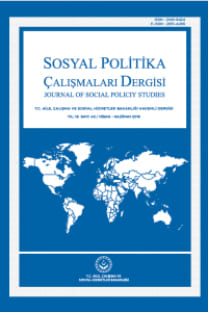Yoksulluğun Kadınlaşması: Altındağ Örneği
Bu çalışma insanlık tarihi kadar eski bir sosyal sorun olan yoksulluğun bir başka boyutu yoksulluğun kadınlaşmasını ele almaktadır. Yoksulluğun sonuçlarından daha derinden etkilenen ve yoksullukla baş etme mekanizmalarını da “içinde yaşadığı aile, bakmakla yükümlü olduğu çocuk, yaşlı veya hasta için” etkili kullanmaya çalışan kadın olduğu için kadın yoksulluğuna spesifik bir gözle bakmak son derece önemlidir. Bu çalışmanın temel amacı; yoksul kadınların genel özelliklerini, yoksulluğu ve kendilerini nasıl değerlendirdikleri ve kadınların yoksullukla ilişkili sorunlarını tartışmaktır. Elde edilen sonuçlardan bazıları şunlardır: Görüşülen kadınların yarıdan fazlası genç yetişkinlik dönemindedir, eğitim düzeyi oldukça düşüktür ve kadınların büyük bir bölümü evlidir. Görüşülen kadınların ve ailelerinin çoğunun oldukça kötü koşulları olan konutlarda yaşadıkları, beslenme, barınma, giyim gibi en temel gereksinimlerini asgari düzeyde dahi karşılayamadıkları saptanmıştır. Sonuç olarak, yaşanan yoksulluğun derinliğinden dolayı kadınların çoğu betimlemektedir ve çoğu kadının aile içi şiddet, beslenme (eksik öğün), fiziksel sağlık (kronik hastalıklar) ve ruh sağlığıyla (depresyon, intihar girişimi) ilgili önemli sorunlar yaşadığı belirlenmiştir.
Anahtar Kelimeler:
yoksullukla ilişkili sorunlar, yoksullukla mücadele ve sosyal hizmet
Feminisation of Poverty: An Example of Altindag Region of Ankara
This study focuses on the feminisation of thepoverty that is the another dimension of poverty as along standing social problem. Women are directlyaffected from the implications of the poverty, and theyare trying to use more effectively the coping mechanismwith poverty on behalf of the family whom they live,and dependent persons of the family as child, elderlyand ill persons, so that it is very important to considerthe women poverty from spesific perspective. Themain purpose of this study is to discuss the generalcharacteristics of poor women, how they consider thepoverty and themselves, and poverty related problems.As a result of this study, more than half of theparticipants are in early adulthood, their educationlevel is low, and most of them are married. It isdetermined that most of the women and their familiesare living in the houses with poor conditions, they cannot meet their basic needs such as food, shelter, anddress in a minimum level. Finally, as a result ofprofound poverty, most women described the povertywith negative connotations, and they experienceviolence at home, food (eating two meals a day),physical health (chronic illnesses), and psychologicalhealth (depression, attempt to suicide) problems.
___
- Banfield, C.E (1973). The Unheavenly Child. Boston: Little Brown.
- Bauman, Z. (1999). Çalışma, Tüketicilik ve Yeni Yoksul- lar, İstanbul, Sarmal Yayınevi.
- Beverley, J. (1999). Subalternity and Representati- on, Duke Unv. Pres, Durham. Akt.: N.Erdoğan. (2002).Yoksulluk Halleri, Türkiye’de Kent yoksul- luğunun Görünümü. Demokrasi Kitaplığı.
- Brown, C. ve N. Madge (1982). Despite The Welfare State, Heinemann EB.
- Çağatay, N. (1998). Gender and Development, UNDP Working Paper Series, 1-17.
- Elmelech, Y. ve Hen-Lu, H. (2004). Race, Ethnicity, and the Gender Gap, Social Science Rearch, 33: 158-182. İnternet Portalı www. Elsevier. com/ lo- cate/ ssresearch. (15.11.2005).
- Erman, T. (1998). Kadınların Bakış Açısından Köyden Kente Göç ve Kentteki Yaşam. 75. Yılda Kadınlar ve Erkekler. İstanbul. Tarih Vakfı Yayını, 211-225.
- Goldberg, G. S. ve Kremen E. (1990). The Feminization of Poverty Discovered in America. Greenwood Pres.
- Harvey D.L. ve M. Reed (1996). The Culture of Poverty: An Ideological Analysis, Sociological Perspecti- ve, 34 (4) 465-95.
- ISSN: 2148-9424
- Yayın Aralığı: Yılda 4 Sayı
- Başlangıç: 2012
- Yayıncı: Aile,Çalışma ve Sosyal Hizmetler Bakanlığı
Sayıdaki Diğer Makaleler
Yoksulluğun Kadınlaşması: Altındağ Örneği
Yrd. Doç. Dr. Gülsüm ÇAMUR DUYAN
Yrd. Doç. Dr. Erdal HAMARTA, Arş. Gör. Önder BALTACI, Prof. Dr. Ömer ÜRE, Uzm. Psik. Dan. Elif DEMİRBAŞ
Okul Öncesi Çocuklarda Uyum ve Davranış Problemleriyle Başa Çıkmada Ailenin Rolü
Huzurevinde Kalan Yaşlıların Hayata Bakış Açıları ve Gelecekle İlgili Beklentileri
Çocuklarda Kitap Okuma Alışkanlığı’na Genel Bir Bakış
Yrd. Doç. Dr. Ebru Hasibe TANJU
Ebeveyn Yoluyla Munchausen Sendromu Olgularında Sosyal Hizmetin Rolü
Yrd. Doç. Dr. Cengiz ÖZBESLER, Dr. Arzu İÇAĞASIOĞLU ÇOBAN
Sosyal Kapitali Yapılandırmak: Sosyal İletişim Ağı ve Yardımseverlik-Gönüllülük
